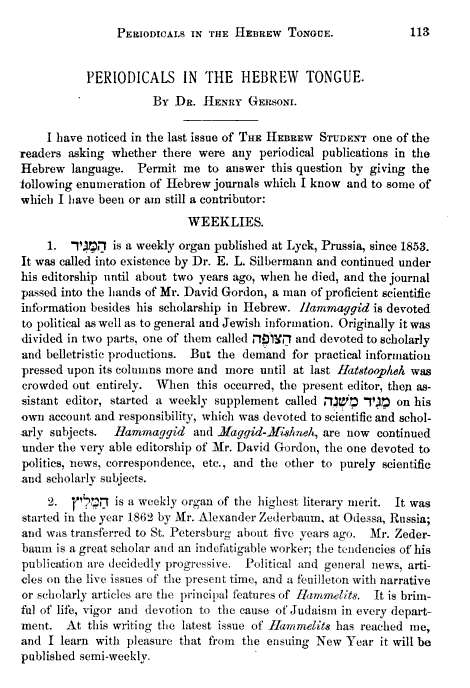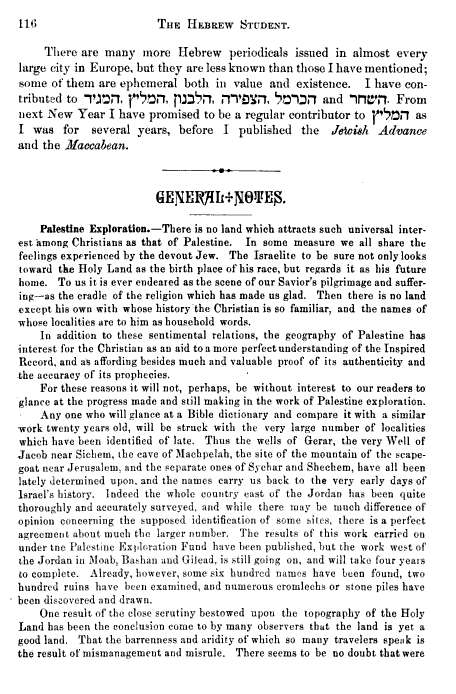When it came to the Hungarian organ of the Ultra-Orthodox, the מחזיקי הדת, (which you can read here) he writes that it "amuses its readers with Kabbalistic hyperbole and ungrammatical Hebrew." Ironically, he adds that "the journal has existed since four years."

You can read more about the Machzikei Hadas newspaper here.
Interestingly, Gersoni is one of the first to write in English about the legendary Count Valentin Potocki in his sketch called The Converted Nobleman; a Historical Narrative. Not only that, he apparently is the one to supply a first name, as in no earlier account - whether in Polish or in English or in Hebrew - is Potocki's first name mentioned. His account will be analyzed, with some further information about the legendary Graf Walentyn Potocki, or Avraham ben Avraham Ger Zedek, martyr of Ilya or Vilna, in a future post soon.
Here is his entire article on "Periodicals in the Hebrew Tongue:"




[1] Gersoni's biography is rather interesting, and it's checkered moments will be discussed in the aforementioned upcoming post.

Perhaps the phraseology is intentional, to lampoon the fractured grammar Mr. Gersoni imagines a chassidishe practitioner might evince? On closer examination, though, the wording is duplicated in at least one other place...so it appears to be a typo.
ReplyDeleteInteresting to note that Gersoni, nonetheless, seems to speaks somewhat respectfully of other orthodox publications.
No, it's a mistake, because he's thinking in Yiddish, not English. It happens, is my point.
ReplyDeleteOn the other hand I think the reason why people harp on Hebrew grammar is precisely because they don't think in it, and either they know it grammatically or they don't - but either way, they make a point of presenting Hebrew a certain way because of how they view the language as more than just another language..
On the topic of this earlier post http://onthemainline.blogspot.com/2009/03/croation-proselyte-who-suffered-similar.html , Wikipedia states as follows:
ReplyDelete"There is some evidence that the Potocki legend is an embellishment of a true story. A report published in the July 1753 edition of The London Magazine describes the story of a very similar execution.... It describes "an apostate named Raphael Sentimany, a native of Croatia" who converted to Judaism and adopted the name Abraham (thus making his religious name Abraham ben Abraham). The report describes his imprisonment and execution in Wilno as the Potocki legend describes. The report also states that he was executed on June 9th, which was the second day of Shavuot, just as in the Potocki story. The only important differences between the Sentimany execution and the Potocki legend are that the martyr was killed in 1753 rather than 1749, and that he was a Croation immigrant rather than a Polish noble.[1] Raphael Sentimany is also mentioned in the anonymous British work "Admonitions from the Dead, in Epistles to the Living", published in 1754, in a manner suggestive of the wide exposure of the original report of Abraham ben Abraham's execution."
"Admonitions from the Dead, in Epistles to the Living" is available on ECCO, I believe.
presumably those involved the hungarian journal learned hebrew in their youth. gersoni, on the other hand, presumably didn't learn english until he was an adult
ReplyDelete(harper though did learn some hebrew in his younger years)
>presumably those involved the hungarian journal learned hebrew in their youth. gersoni, on the other hand, presumably didn't learn english until he was an adult
ReplyDelete(harper though did learn some hebrew in his younger years)
Oh, I know. The juxtaposition was just so amusing that it had to be a post.
TJ, thanks for that reference to the Admonitions.
Good stuff. I've always wanted a summary of the various hebrew papers, b/c I was always mizing up my Hamaggids with my Hameilitzes.
ReplyDeleteDid you notice, in the description of HaMaggid, he says part of it is "belletristic"? Not a common word. It's where Marc Shapiro gets that fancy "belles-lettres" phrase he likes to toss around.
ZG
I bet you tried SOOO hard not to make any grammar mistakes in your post, so that you could avoid the inevitable ribbing. Alas, it was not to be. I found one:
ReplyDelete"Gersoni's biography is rather interesting, and it's checkered moments will be discussed in the aforementioned upcoming post. "
"Its" is supposed to be without the apostrophe.
Rib. Rib.
-- Phil
Interesting as always, Fred.
ReplyDeleteThis is cannibalized from a post on my own blog that sometime or other I may actually get around to posting. Anyhow, here's a paragraph from the intro to the Birnbaum siddur: "By the end of the seventeenth century, printers had become careless in reproducing prayer books. May printer's errors crept in, as well as mistakes in grammer. The eighteenth century has been credited with the effort to correct the text of the Siddur, but this was not fully accomplished until the nineteenth century, with the editions of Wolf Heidenheim and Seligman Baer. The Siddur of Rabbi Jacob Emden was perhaps the best produced of the eighteenth century."
In this paragraph, both "grammar" and "Seligmann" are misspelled. The point isn't to make fun of Birnbaum; it is that all of us, including me, should tread cautiously when pointing out errors. Not that we shouldn't point them out--we should just be aware that we too are very likely carrying on the tradition of introducing errors.
Hoops!, vey'z mir!, gevald!, and shrek! "May printer's errors"? That was me, not Birnbaum.
ReplyDeleteSo, like I was saying...
To clarify, if it's unclear: "may" should have been "many."
ReplyDeleteMike,
ReplyDeleteThere are typos and there are solecisms. They signify different things and often, as in these cases, they can be told apart
Why did I think Potocki was called Hagraf Pototzki in the Gra's commentary on Orach Chayyim? Perhaps I'm remembering a secondary source.
ReplyDeleteThe Gra never mentions him. (Probably because he never existed.)
ReplyDeleteThere is only one somewhat important source tying him to the Gra, namely that one of his primary talmidim, R. Mendel of Shklov is quoted by the Christian missionary Wolf mentioning him by (last) name, but nothing about the Gra. Every other source is very late, he isn't mentioned where he should be, eg, in Aliyos Eliyahu, etc.
I used to think that despite the fact that he is missing, there could be good explanations for it, but now I am reasonably convinced that his story was grafted (no pun intended) onto Rafael Sentimany who ALSO was a ger called Avraham ben Avraha, who ALSO lived in Ilya, and who ALSO was killed on or very near Shavuot, albeit in 1753, in Vilna. His tongue was ALSO pulled out, and he ALSO was said to not react to the pain. I think he is the real Araham ben Avraham and the Gra may or may not have had anything to do with him, and we'll probably never know. So many of the elements of the story were grafted on from other situations, like the martydom speech by R' Mann of Vilna. It's very nice that the rebbes of the first generation of European American roshe yeshiva adopted this legend as their own, but I think it was based on Sentimany a"h, the unsung martryed convert of Vilna who did exist and no one knows about or mentions.
Got it? :0)
Wow that was unusual. I just wrote an very long comment but after
ReplyDeleteI clicked submit my comment didn't appear. Grrrr... well I'm not writing all that over again.
Anyhow, just wanted to say fantastic blog!
Feel free to surf to my website; ford ranger